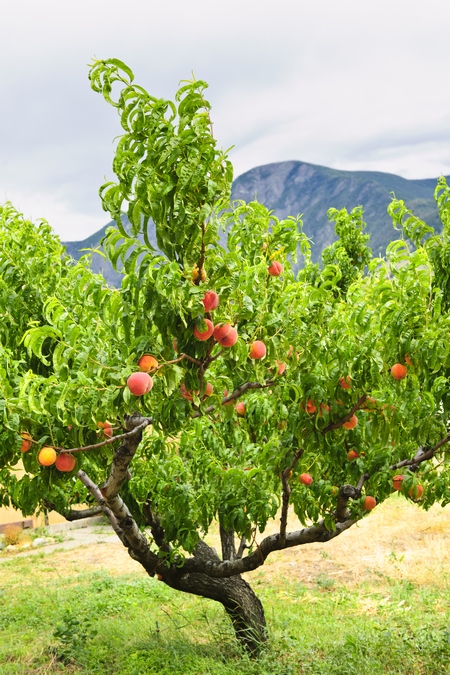 PEACH
PEACH
The height of peach trees is from 4 into 8 m. They have a very developed root system, growing deep on lighter soils. Peaches have green or red shoots, resembling willow. Peach leaves are lanceolate, similar to willow leaves, Length 7-15 Cm, Width 2-4 Cm; the edges have "ball-shaped”. At the base of the leaf blade there are glands of spherical or kidney-shaped shape. The fruit of the peach is a drupe set on a very short peduncle, which at harvest remains on the twig. Fruits are of different sizes, mostly with a diameter 5-8 Cm, Weight 40-300 g. The skin of the fruit is mossy, less smooth, yellow-green with a weaker or more vivid blush. Fruits with a smooth skin are called nectarines. Peaches live on average about 30 lat, and sometimes even 50. In our conditions, trees live at most 16-20 lat. Their distinctive feature is a short period of rest. Vegetation begins in spring very early – already at the end of March and bloom before the development of leaves, mostly at the end of April. Peaches enter the fruiting period as early as the second year after planting to a permanent place. With careful care, good knowledge of care and cultivation and the right selection of varieties can be obtained from peaches almost annually yields of beautiful and tasty fruits. Of the fruit trees peaches, next to apricots, have the highest climatic requirements and therefore should be planted only on the warmest positions - places with sunlight and sheltered from strong winds. Require warm soils, deep and fertile, with a groundwater level below 2 m and reaction close to neutral. Grow well on soils with a limestone substrate. Especially winters with large temperature fluctuations are the most dangerous for peaches. During the period of deep dormancy of winter peach trees can withstand temperatures up to – 20°C, while after the rest subsides, in the early spring, after periods of warming, temperatures of a few degrees below zero can already cause more damage. Flower buds are then most often frozen, and even young fruit buds. These damages are the main causes of weak, not every year, fruiting.
Peach trees should be planted in a spacing of 4X2 or 4X3 m, only annuals, because the elderly are badly received, and a little deeper than they grew in the nursery. Trees planted in autumn should be sprinkled with earth, so that a mound of about 50 Cm. The part of the tree protruding above the mound should be wrapped with straw or paper. The method of forming and cutting peaches was discussed earlier.
The group of basic varieties recommended for amateur cultivation includes the following varieties:
Reliance – this is the variety considered the most frost-resistant of the varieties with yellow fruit flesh. Medium early, ripens in early August.
red haven – American variety. The tree grows vigorously, forming a spherical crown very thickened. It enters the fruiting period already in the second year after planting and bears fruit abundantly. Fruits are large, golden yellow with bright, red blush. The flesh is orange, juicy, refreshing, spicy, aromatic, very tasty, well off the stone. Fruits ripen in the second decade of August. Sometimes it is very difficult to determine the date of harvest, because the fruits turn very early. They are harvested as they mature, gradually.
Veteran – Canadian variety. The tree grows quite vigorously, forming a spherical crown, medium size. Large leaves, with a pointed apex, with a wavy and wrinkled surface and finely corrugated edges. Fruiting trees require strong cutting and good fertilization, especially potassium. It produces medium-sized fruit, about weight 90-120 g, spherical, Irregular, with one half usually strongly overgrown. Light orange peel, with a bright blush, blurry and dotted, covering a significant part of the surface. Yellow-orange flesh, with a greenish pit with red veins, medium strict, fibrous, juicy, sweet, slightly acidic, aromatic, tasty, partially adherent to the pit. Fruits ripen in the second or third decade of August.
Rakoniewicka – it is a Polish variety, recommended only for warmer regions. Trees grow strongly and are resistant to diseases. Can be propagated from seeds, because it quite faithfully repeats the maternal qualities. Fruits produce medium size, spherical, light green with carmine blush, Tasty. They ripen in early September.
From the group of complementary and prospective varieties, the selection lists three varieties:
Kiev Early – comes from Russia. The tree grows quite vigorously, forming a spherical crown, slightly sprawling, strongly concentrated. The ripening period enters in the second year after planting. Bears fruit abundantly and regularly. Requires strong cutting and good fertilization. Medium-sized fruit, spherical or slightly elongated, with a clear tip. Skin greenish white, with bright red, marbled blush on almost the entire surface, strongly, light mossy, strong and thick. Cream-white flesh, medium strict, dissolving, aromatic. Fruits ripen in the second half of July.
Juicy – also from Russia. The tree forms a wide crown, concentrated. It enters the fruiting period very early and bears fruit very abundantly, regularly. It produces medium-sized fruit, spherical, Regular, slightly truncated at the apex. Light green peel with bright, carmine, dotted and striped blush on almost the entire surface of the fruit, strongly mossy. Cream-white flesh, very sweet, juicy, with a pleasant sourdough, refreshing. Ripens in early August.
Meredith is an American variety. The tree grows not very strongly, begins to bear fruit early, regularly and abundantly. The fruit is large, dark orange with red blush. The flesh is yellow, sweet and sour, juicy, tasty. Fruits d